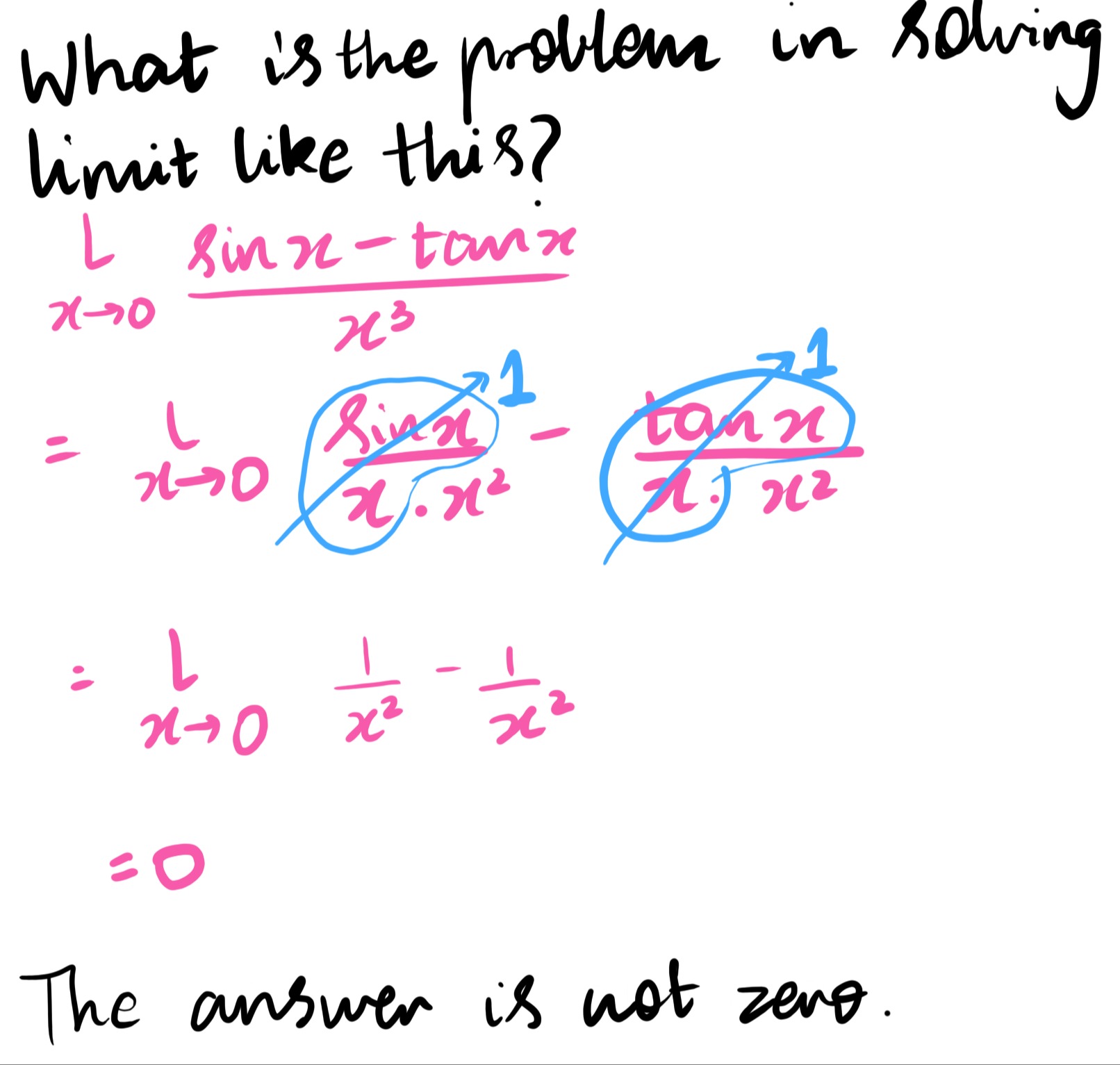Question
Question: What is the problem in solving limit like this? $\lim_{x\to0} \frac{sinx-tanx}{x^3}$ = 0 The answ...
What is the problem in solving limit like this?
limx→0x3sinx−tanx
= 0
The answer is not zero.

The problem is the incorrect application of limit properties leading to an indeterminate form that is wrongly evaluated. The correct answer is -1/2.
Solution
The problem in the provided solution lies in the incorrect application of limit properties. The solution attempts to use the standard limits limx→0xsinx=1 and limx→0xtanx=1 prematurely.
The expression is limx→0x3sinx−tanx. The provided solution rewrites this as limx→0(x⋅x2sinx−x⋅x2tanx). Then, it replaces xsinx with 1 and xtanx with 1, leading to limx→0(x21−x21). The error occurs in this replacement step. While limx→0xsinx=1 and limx→0xtanx=1, these equalities hold only in the limit sense. Replacing xsinx and xtanx with the constant value 1 within the expression before the limit is fully evaluated is incorrect, especially when they are multiplied by a term like x21 which tends to infinity as x→0.
Specifically, the property limx→a(f(x)−g(x))=limx→af(x)−limx→ag(x) is only valid if the individual limits limx→af(x) and limx→ag(x) exist and are finite. In this case, if we consider f(x)=x3sinx=xsinx⋅x21 and g(x)=x3tanx=xtanx⋅x21, then limx→0f(x)=limx→0xsinx⋅limx→0x21=1⋅∞=∞ and limx→0g(x)=limx→0xtanx⋅limx→0x21=1⋅∞=∞. The original limit is of the indeterminate form ∞−∞. The student incorrectly assumes that ∞−∞=0.
The correct approach requires evaluating the limit of the entire expression together, for example, by using Taylor series expansions or L'Hopital's rule.
Using Taylor series expansions around x=0: sinx=x−6x3+O(x5) tanx=x+3x3+O(x5) sinx−tanx=(x−6x3)−(x+3x3)+O(x5)=−6x3−3x3+O(x5)=−63x3+O(x5)=−2x3+O(x5)
So, limx→0x3sinx−tanx=limx→0x3−2x3+O(x5)=limx→0(−21+O(x2))=−21.
The problem in the solution is the incorrect application of limit properties when dealing with indeterminate forms involving infinity. The standard limits limx→0xsinx=1 and limx→0xtanx=1 are based on the leading term of the Taylor series expansion. For this limit, where the denominator is x3, we need to consider higher-order terms in the expansion of the numerator. Replacing xsinx and xtanx with 1 is equivalent to using the approximation sinx≈x and tanx≈x, which is too crude for this limit problem.
The final answer is −1/2.
Explanation of the solution: The provided solution incorrectly applies limit properties. It replaces terms xsinx and xtanx with their limit (1) while they are multiplied by x21, which tends to infinity. This leads to an indeterminate form ∞−∞, which is then incorrectly evaluated as 0. The property lim(f(x)−g(x))=limf(x)−limg(x) is valid only if the individual limits exist and are finite. Correct evaluation requires methods like Taylor series expansion or L'Hopital's rule, which yield the limit −21.
